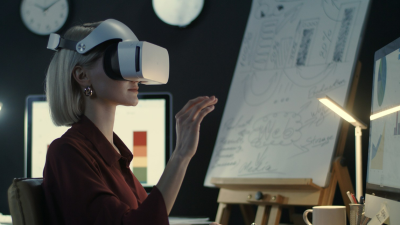The digital world continuously evolves with technologies that blur the line between physical and virtual realms. Two terms frequently mentioned in this context are holograms and augmented reality. While many use these terms interchangeably, they represent distinct technological concepts with unique characteristics and applications. This exploration clarifies their relationship and highlights why understanding their differences matters for businesses and consumers alike.
Defining Holograms
Holograms represent three-dimensional images created through light diffraction, capturing the light field of an object rather than simply projecting a flat image. Traditional holograms exist independently of viewing devices, appearing as three-dimensional objects visible from multiple angles without requiring special eyewear. These photographic recordings distribute light in a way that recreates the original light field, giving viewers the impression of seeing a three-dimensional object even though nothing physically exists in that space.
The science behind holography dates back to 1947 when Dennis Gabor developed the theory while working to improve electron microscopes. However, practical holography only became possible after the invention of lasers in the 1960s provided the coherent light source necessary for creating detailed holograms. Since then, holographic technology has advanced considerably, finding applications in security features on credit cards, artistic displays, and medical imaging.
Modern holographic displays have moved beyond static recordings to dynamic projections that can change in real-time. Despite technological advances, true holograms maintain certain defining characteristics: they present three-dimensional images visible from different angles, they use light diffraction rather than perspective tricks, and they exist in physical space without requiring a specific viewing device to see them.
Understanding Augmented Reality
Augmented reality takes a fundamentally different approach by overlaying digital content onto our view of the physical world. Unlike holograms, AR requires a technological intermediary – typically a smartphone, tablet, or specialized glasses – to view the digital elements. The technology uses cameras, sensors, and displays to add context-specific information or visual elements to our perception of real environments.
The AR experience depends entirely on the viewing device, which tracks the physical environment and positions virtual objects accordingly. This mediated view distinguishes AR from true holography, as AR objects exist only within the digital realm of the device. When you remove the AR device, the digital overlay disappears completely, unlike holograms which physically manipulate light in space.
According to research from the MIT Media Lab, augmented reality applications have grown exponentially across industries ranging from retail to healthcare. The technology enhances real-world functionality by adding layers of useful information rather than creating standalone visual objects. At ARMarketingTips.com, we’ve documented numerous case studies where businesses significantly improved customer engagement through well-designed AR experiences that complement their physical products or spaces.
Where Confusion Arises
The confusion between holograms and augmented reality often stems from popular media portrayals and marketing terminology. Science fiction has frequently depicted advanced holographic technology as interactive, programmable objects existing in physical space without viewing devices – capabilities that combine elements of both technologies but don’t accurately represent either in their current form.
Further complicating matters, many tech companies market their AR products using holographic terminology. Microsoft’s HoloLens, for example, describes its augmented reality headset as creating “holograms,” though the experiences it delivers are actually AR projections visible only through the device. This marketing language, while evocative, blurs important technical distinctions.
Even more confusion comes from smartphone “hologram” videos that use simple reflection techniques with pyramid-shaped plastic or glass to create floating images. These are neither true holograms nor augmented reality, but rather optical illusions based on the Pepper’s Ghost technique dating back to the 19th century. They lack the three-dimensional depth and parallax viewing angles of genuine holograms.
The Technical Intersection
Despite their differences, holograms and augmented reality share certain technical goals – namely, the convincing integration of virtual elements with our perception of physical space. Both technologies aim to create immersive experiences that extend beyond flat screens and two-dimensional interfaces.
Recent advances in light field displays represent a technological convergence that borrows from both holographic principles and AR applications. These displays project different images to each eye based on position, creating more convincing three-dimensional visuals without traditional AR headsets. Companies like Looking Glass Factory have developed holographic displays that show three-dimensional content visible to multiple viewers simultaneously without special glasses, bridging the gap between traditional holograms and digital content creation.
Volumetric displays offer another path toward convergence, generating visual objects that occupy physical space rather than just creating the illusion of depth. These systems use various techniques including rapidly rotating screens, multiple layered displays, or specially engineered materials to create light points in actual three-dimensional space, moving closer to the science fiction vision of programmable matter.
Applications Across Industries
The practical applications of holograms and augmented reality reveal their distinct strengths. Medical education increasingly uses AR for anatomy visualization, allowing students to see labeled structures overlaid on actual bodies or models. Automotive heads-up displays employ AR principles to project navigation information directly onto windshields, keeping drivers’ attention on the road.
True holographic technology finds specialized applications in data visualization, artistic installations, and certain retail displays. Holographic telepresence represents a promising frontier, potentially allowing three-dimensional representations of people to appear in remote locations without requiring viewers to wear special equipment.
Entertainment applications frequently combine elements from both technologies. Concert performances by deceased artists like Tupac Shakur or Michael Jackson often described as “holograms” typically use a modern version of the Pepper’s Ghost illusion rather than true holography. Meanwhile, AR applications like Pokémon GO overlay digital characters onto smartphone camera feeds, creating engaging experiences that blend virtual and physical worlds.
Looking Toward Future Convergence
The future likely holds greater convergence between holographic and augmented reality technologies. Research into materials that can dynamically diffract light in programmable ways might eventually enable true holographic displays that can change in real-time without projection systems. Similarly, AR technology continues moving toward less obtrusive viewing devices, with companies developing lightweight glasses and eventually contact lenses that could make the technology nearly invisible.
Several technical challenges must be overcome before this convergence becomes reality. Creating dynamic holographic materials requires unprecedented control over the optical properties of physical substances. AR technology must become substantially more power-efficient and miniaturized to fit into everyday wearables while providing convincing experiences.
The distinction between holograms and AR may eventually disappear as technologies mature. The ultimate goal for both approaches involves seamless integration of digital information and objects into our physical world. Whether this comes through advanced materials that manipulate light or through unobtrusive personal displays may ultimately matter less than the experiences they enable.
Making Practical Distinctions Today
For businesses and developers working with these technologies today, understanding the distinction between holograms and augmented reality remains important for practical reasons. AR development requires expertise in software interfaces, camera tracking, and digital content creation. Holographic displays involve more specialized knowledge of optics and light physics.
Project requirements should determine technology choice. If users need individualized experiences with interactive elements that respond to their specific position or actions, AR typically offers the more practical solution. For public displays intended to create visual impact for multiple simultaneous viewers without requiring special equipment, holographic techniques might prove more appropriate.
Budget considerations also differ substantially. AR experiences can often leverage existing consumer devices like smartphones, while holographic displays typically require specialized and sometimes expensive equipment. This cost difference explains why AR has seen more widespread commercial adoption despite holography’s visual appeal.
Understanding these technologies beyond their marketing terminology helps organizations make informed decisions about which solutions best address their specific needs. Whether enhancing product visualization, creating memorable brand experiences, or developing educational tools, clarity about technological capabilities ensures resources target appropriate solutions rather than chasing misunderstood concepts.
The relationship between holograms and augmented reality illustrates how technological evolution rarely follows straight lines. These distinct approaches to blending digital and physical realities continue developing along parallel paths, occasionally borrowing from each other but maintaining their unique characteristics. As they advance, both technologies promise to transform how we experience information, entertainment, and communication in increasingly immersive ways.





